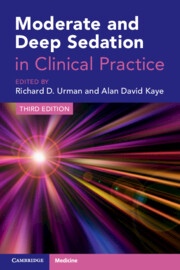Book contents
- Moderate and Deep Sedation in Clinical Practice
- Moderate and Deep Sedation in Clinical Practice
- Copyright page
- Epigraph
- Contents
- Contributors
- Preface
- Chapter 1 Introduction to Moderate and Deep Sedation
- Chapter 2 Pharmacology Principles in Sedation
- Chapter 3 Pain Assessment and Management Considerations
- Chapter 4 Patient Evaluation and Procedure Selection
- Chapter 5 Patient Monitoring, Equipment, and Intravenous Fluids
- Chapter 6 Credentialing, Competency, and Education
- Chapter 7 Quality, Legal, and Risk Management Considerations: Ensuring Program Excellence
- Chapter 8 Nursing Considerations for Sedation
- Chapter 9 Physician Assistants and Nurse Practitioners
- Chapter 10 High-risk Patients: Sedation Considerations in Coexisting Disease
- Chapter 11 Respiratory Compromise in Moderate and Deep Sedation
- Chapter 12 Management of Complications of Moderate and Deep Sedation
- Chapter 13 Recovery and Discharge After Monitored Anesthesia Care
- Chapter 14 Outcomes, Controversies, and Future Trends
- Chapter 15 Simulation Training for Sedation
- Chapter 16 Sedation in the Interventional Radiology Suite
- Chapter 17 Sedation in Endoscopy
- Chapter 18 Sedation in the Interventional Cardiology Suite
- Chapter 19 Sedation and Anesthesia for Interventional Pulmonary Procedures
- Chapter 20 Sedation for Ophthalmological Procedures
- Chapter 21 Procedural Sedation in the Emergency Department
- Chapter 22 Sedation in the Intensive Care Setting
- Chapter 23 Pediatric Sedation: Practical Considerations
- Chapter 24 Safety and Outcomes in Pediatric Sedation
- Chapter 25 Sedation in the Office and Other Outpatient Settings
- Chapter 26 Sedation in Dentistry
- Chapter 27 Sedation for Assisted Reproductive Technologies
- Chapter 28 Interventional Pain Management Procedures
- Chapter 29 Emergency Resuscitation Algorithms: Adults
- Chapter 30 Emergency Resuscitation Algorithms: Infants and Children
- Guidelines and Standards
- Index
- References
Chapter 18 - Sedation in the Interventional Cardiology Suite
Published online by Cambridge University Press: 12 December 2024
- Moderate and Deep Sedation in Clinical Practice
- Moderate and Deep Sedation in Clinical Practice
- Copyright page
- Epigraph
- Contents
- Contributors
- Preface
- Chapter 1 Introduction to Moderate and Deep Sedation
- Chapter 2 Pharmacology Principles in Sedation
- Chapter 3 Pain Assessment and Management Considerations
- Chapter 4 Patient Evaluation and Procedure Selection
- Chapter 5 Patient Monitoring, Equipment, and Intravenous Fluids
- Chapter 6 Credentialing, Competency, and Education
- Chapter 7 Quality, Legal, and Risk Management Considerations: Ensuring Program Excellence
- Chapter 8 Nursing Considerations for Sedation
- Chapter 9 Physician Assistants and Nurse Practitioners
- Chapter 10 High-risk Patients: Sedation Considerations in Coexisting Disease
- Chapter 11 Respiratory Compromise in Moderate and Deep Sedation
- Chapter 12 Management of Complications of Moderate and Deep Sedation
- Chapter 13 Recovery and Discharge After Monitored Anesthesia Care
- Chapter 14 Outcomes, Controversies, and Future Trends
- Chapter 15 Simulation Training for Sedation
- Chapter 16 Sedation in the Interventional Radiology Suite
- Chapter 17 Sedation in Endoscopy
- Chapter 18 Sedation in the Interventional Cardiology Suite
- Chapter 19 Sedation and Anesthesia for Interventional Pulmonary Procedures
- Chapter 20 Sedation for Ophthalmological Procedures
- Chapter 21 Procedural Sedation in the Emergency Department
- Chapter 22 Sedation in the Intensive Care Setting
- Chapter 23 Pediatric Sedation: Practical Considerations
- Chapter 24 Safety and Outcomes in Pediatric Sedation
- Chapter 25 Sedation in the Office and Other Outpatient Settings
- Chapter 26 Sedation in Dentistry
- Chapter 27 Sedation for Assisted Reproductive Technologies
- Chapter 28 Interventional Pain Management Procedures
- Chapter 29 Emergency Resuscitation Algorithms: Adults
- Chapter 30 Emergency Resuscitation Algorithms: Infants and Children
- Guidelines and Standards
- Index
- References
Summary
As new medical techniques and technologies develop, the number of non-surgical interventions continue to evolve. The anesthesiologists’ role in non-operating room anesthesia (NORA) locations continues to expand. In a study of the National Anesthesia Clinical Outcomes Registry, Nagrebetsky et al. found that the proportion of NORA cases increased from 28% in 2010 to 36% in 2014 alone [1]. Interventional cardiology and electrophysiology procedures are no exception to this, as they have continued to develop into fields that offer advanced and comprehensive therapies to treat a wide variety of cardiac pathologies. With the ever-growing success rate of percutaneous approaches to pathologies that once needed surgical intervention, the target patient population has broadened. As such, the increased need for anesthesia services in the interventional cardiology suite reflects a major expansion of our practice perimeter.
- Type
- Chapter
- Information
- Moderate and Deep Sedation in Clinical Practice , pp. 235 - 244Publisher: Cambridge University PressPrint publication year: 2024

